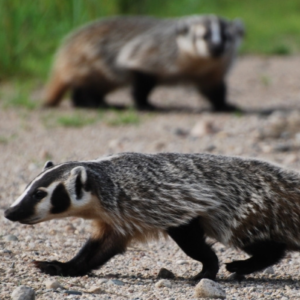Whip-poor-will
This nocturnal bird’s eggs hatch about 10 days before the full moon… because they lay in time with lunar cycles. Save endangered species today by joining one of our campaigns!
Help End the ExtinctionVital Signs
- Common name: Whip-poor-will
- Latin name: Caprimulgus vociferus
- Conservation Status: Threatened
- Range: Saskatchewan, Manitoba, Ontario, Quebec, New Brunswick, Nova Scotia
- Life span: 13-15 years
- Size: 22-26 cm in length, weigh 43-64 g, wingspan of 45-48 cm

The Whip-poor-will has a flat head, large eyes, and a small beak. There are long feathers around the beak that are used to help sense flying insects, which are the Whip-poor-will’s main food source. They have grey and brown feathers and a “collar” marking on the breast, but the male’s is white and the female’s is buff.
Whip-poor-will Facts
- Is the Eastern Whip-poor-will, but is just called Whip-poor-will since there aren’t any other subspecies in Canada
- Is a nocturnal bird
- Got its name from its song, which sounds like “whip poor will”
- Their feather colours help them blend in with tree bark, and makes them very difficult to see

Threats
The Whip-poor-will is facing a loss of prey. The availability of insects is decreasing due to the use of pesticides and climate change.
They are also experiencing habitat loss, as they only live in patchy forest areas. While they are losing some habitat to cropland, they are also losing habitat to forest agriculture since they won’t nest in dense trees.
Whip-poor-wills also have an increased rate of being hit by vehicles at night. They commonly sit on road shoulders and gravel roads, which leaves them vulnerable.
What’s Being Done
This species is federally protected under the Species At Risk Act, and is also protected under the Migratory Birds Convention Act (1994). They also experience protection where they occur in provincial parks and reserves.

Canada has committed to the goal of protecting 30% of lands, ocean, and freshwater in Canada by 2030. This goal will help protect ecosystems, restore habitats, and fight climate change. All these things are a step in protecting Canada’s at-risk animals—so let’s hold the federal government to their promise.
How to Help
- Inspire Change: Encourage the reduction or elimination of pesticides and biocides in agriculture and forestry. You can also avoid using pesticide on your lawn
- Take Part: Join a bird count or enter your data online if you hear their distinctive call.
- Help Out: Tell elected officials you favour permanent protection of Whip-poor-will habitat
- Learn: Stay informed about endangered birds and other species. Sign up for Nature Canada’s monthly e-newsletter.
- Find out more: Help us end the extinction by taking action for nature today—visit conservation websites like Nature Canada or join one of our campaigns!
Resources
- The Cornell Lab – Eastern Whip-poor-will
- COSEWIC – Assessment and Status Report
- SARA – Species Profile



